

2/23/7 - 3/1/7
john cribbs
In October 2006, Funderburg and Cribbs set out to watch at least 200 movies over the course of the next 200 days. They both watched a different slate of films and wrote about every single one; from epic high art masterpieces such as Max Ophul's The Earrings of Madame de... to lesser films by great directors like Richard Linklater's It's Impossible to Learn to Plow by Reading Books to idiotic dreck like A Night at the Museum. The Pink Smoke is reprinting their writings about the puzzling experiment in cinematic endurance.
<<click here for 2/10/7 - 2/22/7>>
2.23. The Exorcist III: Legion.
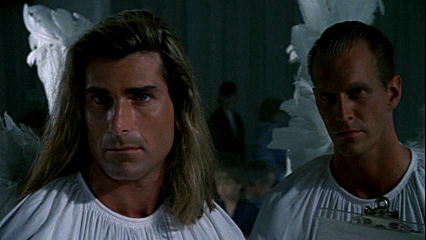 I have a weird relationship with the
Exorcist films. I like the idea of the first movie (and the original
novel) much better than the movie itself. The second is famously abysmal: it
upset me to learn that Martin Scorsese is a fan, as it cheapens his endorsement
of truly underrated movies like Cemetery Man and Shakes the
Clown.) The twin prequels are an evening's curiosity I've not yet indulged
in. And then there's Blatty's own film, an adaptation of his literary Exorcist
follow-up Legion, which is equally ridiculous and amazing. Taking place 15 years
later, this one sees minor characters from the first film being picked off by
possessed old ladies. I think the most interesting angle of the movie is that it
basically poses the question "What if the world were subtly coming to an end and you were the only one who noticed it happening?"
I have a weird relationship with the
Exorcist films. I like the idea of the first movie (and the original
novel) much better than the movie itself. The second is famously abysmal: it
upset me to learn that Martin Scorsese is a fan, as it cheapens his endorsement
of truly underrated movies like Cemetery Man and Shakes the
Clown.) The twin prequels are an evening's curiosity I've not yet indulged
in. And then there's Blatty's own film, an adaptation of his literary Exorcist
follow-up Legion, which is equally ridiculous and amazing. Taking place 15 years
later, this one sees minor characters from the first film being picked off by
possessed old ladies. I think the most interesting angle of the movie is that it
basically poses the question "What if the world were subtly coming to an end and you were the only one who noticed it happening?"
The man in question is George C. Scott, playing a new character with ties to ones from the original film. He;s an
investigator who delves a little too deep in demonic territory (preceding In
the Mouth of Madness; Sam Neill and Ninth Gate;s Johnny Depp); his
frustration over the mounting gory sacrifices of innocent lives metastasizes
into literal hell on earth. It;s not much of a stretch to propose that all the
spider-women and hooded decapitators are the crisis of faith. Scott is an acting
dinosaur, towering above the cast - which reunites The Ninth
Configuration's Ed Flanders and Jason Miller, but also includes Brad Dourif and
Nicol Williamson (usually a Bargain Basement Connery, here a Bargain Basement
Max von Sydow) - like a bear standing on two legs poised to strike at any
moment. His monologue about the carp in the bathtub is made all the more
uncomfortable by his quiet, grizzled delivery ("Have you noticed how close we're
standing together? I STINK.") I don't know if Blatty's pervo perception of a
society on the brink of utter chaos is quite as smart as he'd like to think at
the end of the day it's Lovecraftian a-white-man-set-them-free fantasy
storytelling but it plays well. Keep your eyes open for weird cameos from
Samuel L. Jackson, Fabio and (as the Angel of Death) Patrick
Ewing.
2.24. Letters from Iwo Jima.
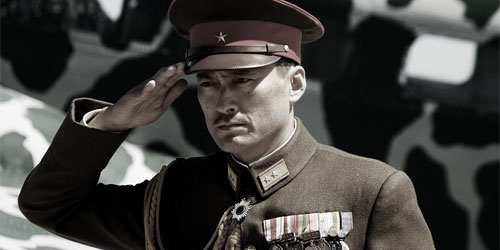
The success of Iwo Jima over
its blandly received big brother Flags of Our Fathers seems like an
accident. I'm sure Eastwood is as surprised as anybody that his comparatively
scaled-down story of the battle's losing side scored big with audiences and the
Academy Awards. Key to the film's success is its complete lack of old Japanese
guys reminiscing about the struggle to their note-scribbling children, probably
because there weren't many of them left to do the telling. In the opening scene,
modern site diggers unearth war artifacts like they were fossils from an empire
long-since vanished, a civilization that's hard to imagine having ever existed
on earth. And, honestly, it is hard to imagine an entire civilization of people
almost instinctually predetermined to fight a battle where there's no hope of
victory. Once the battle's actually started they're too busy killing each other and themselves to defend the island.
Eastwood approaches the Japanese out of pity for the dehumanization caused by their dedication to honor and sacrifice,
which would be an interesting way to look at any military establishment but here
is certainly a better take than their being demonized as tiny feral gremlins
that sneak out of the shadows to take you as they were in Flags. There's
still an amount of American moralizing, mainly in what's meant to be Japanese
ignorance regarding how monstrous U.S. troops are. The scene where an American
executes two unarmed Japanese soldiers simply because it's inconvenient to watch
over them is ballsy, but of course the one to actually pull the trigger has to
be smoking, setting him apart in a way that says: "See? Not all people smoke,
just like not all Americans are casual murderers." It's also not without
sentimentality: you'd think they might have fared battle in the battle if they
hadn't spent so much time gathered solemnly around dead countrymen. But those
are small things to complain about: overall this is Clint's best effort since
Unforgiven, and my mind is still haunted by such memorable scenes as the
barking dog flashback. Ken Watanabe, playing the true last samurai, reminded me
of a civil war general the way his career has familiarized him with both
cultures yet he's ultimately obligated to fight for his own country, whether he
agrees with the military politics or not. Incidentally, his performance is
outstanding.
2.25. Dirty Mary Crazy
Larry.
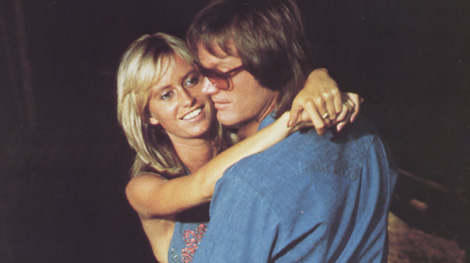 Much as I gushed about Vanishing
Point earlier in 200 Days and 200 Movies, I've decided that the mythic road movie might be
the most annoyingly self-glorifying of subgenres. Grindhouse didn't help:
next to Point, this is the movie that got the most mentions in
Tarantino's atrociously boring half of that Weinstein wreck. When I really think
about it, Two Lane Blacktop is the only clear masterpiece of its kind.
Ever since Easy Rider, the mysticism of the road movie has inflated to
levels of alleged deep meaning. Not that those kind of films weren't already a
little overrated circa-1969: Robert Mitchum's Thunder Road (which gets a
Tarantino-sized shout-out in this movie) isn't very good either. Sometimes a
free spirit in a car doesn't symbolize anything beyond that. But even the
reliable stables of this kind of movie existentialism, fatalism, the feeling
of freedom feel forced into this story of three crooks riding as far away from"the man" as possible.
Much as I gushed about Vanishing
Point earlier in 200 Days and 200 Movies, I've decided that the mythic road movie might be
the most annoyingly self-glorifying of subgenres. Grindhouse didn't help:
next to Point, this is the movie that got the most mentions in
Tarantino's atrociously boring half of that Weinstein wreck. When I really think
about it, Two Lane Blacktop is the only clear masterpiece of its kind.
Ever since Easy Rider, the mysticism of the road movie has inflated to
levels of alleged deep meaning. Not that those kind of films weren't already a
little overrated circa-1969: Robert Mitchum's Thunder Road (which gets a
Tarantino-sized shout-out in this movie) isn't very good either. Sometimes a
free spirit in a car doesn't symbolize anything beyond that. But even the
reliable stables of this kind of movie existentialism, fatalism, the feeling
of freedom feel forced into this story of three crooks riding as far away from"the man" as possible.
The film starts out as a scary heist movie, with Adam Roarke creepifying as a man who takes hostage the family of a supermarket
manager (Roddy McDowell, in the Henry Gibson role.) But it turns out Roarke's a
good guy, and with pals Larry (Peter Fonda) and Mary (Susan George I can't
remember if she was attractive in Straw Dogs but she's hideous in this movie.) I
thought it would be funny if Roarke was named "Harry" but his name is "Deke." Is
"Dirty Mary" supposed to be some kind of play on "Dirty Harry?" Dirty
Harry is a much better movie. The one thing this film does have going for it
is the language of the road: moods and tone related through signs on the side of
the road ("Seattle," "Out to lunch") and ironic bumper stickers. That aspect is
kind of interesting, but isn't quite enough to be memorable. Eerily, Vic Morrow
spends most of the film in a helicopter that's running out of gas: there's even
a really unfortunate moment where he's watching it land dangerously near some
power lines and I couldn't help thinking, "Whoops."
2.26. Chronicle of a
Disappearance.
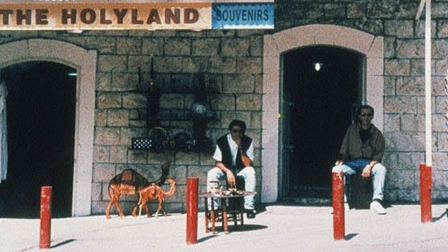
Elia Suleiman is an excellent narrative filmmaker, which sort of creates a conflict when handling the sort of material he is here. It works when he's intercutting scenes with talking heads: the priest saying "anyone can walk over
water and make miracles now" as the jet skis cruise the surface of Lake
Kinneret, or the old man relating his grandfather's story of "sparkling pans" in
Istanbul. It's less effective when the film moves to Jerusalem and becomes
almost a stylized, surrealist thriller - not that some of this stuff isn't great
too, but the two styles don't fit together. Still, images of the man toking a
hookla while playing computer backgammon and the line of cops leaping out of a
truck in formation to line up for a piss are pretty priceless.
What Time Is It
There?.
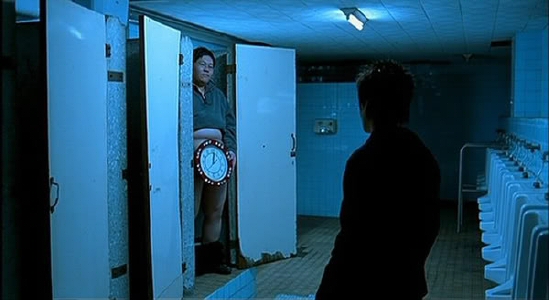
When I see a Tsai Ming-liang film in the theater, I get the ultimate experience of being alone, because that's what his movies are about. And while
I'm a fan of his deliberate pacing, Bresson-style single shots and minimalist
acting, what was missing from Goodbye Dragon Inn and The Wayward
Cloud were relatable characters, which this one has. It's most instantly
comparable to Wong Kar-Wai's Days of Being Wild, as it thematically links
these characters by time. A man, after selling a watch with dual time to a woman
who's traveling to Paris, starts setting all the clocks in Taiwan to Paris
hours, resulting in parallel visual motifs between the two of them as well as
surreal concurrences (he watches 400 Blows, she runs into Jean-Pierre
Leaud in a cemetery). Like Chronicle of a Disappearance, it opens and
closes with quiet scenes featuring an old man (in Chronicle, I imagine
it's Suleiman's father - here it's Miao Tien) that bookend the stories very
nicely. Also... best-lit masturbation scene in film history (sorry, Marc
Reshovsky).
2.27. Bubble.
 This is the first of several small movies Steven Soderbergh signed up to make, and the fact that none of the actors
being interviewed on the dvd extras are laughing about that time Catherine
Zeta-Jones snorted champagne off Brad Pitt's back on George Clooney's yacht off
the coast of Sicily is a good thing. I avoided this film because I wasn't sure
what to think of the politics behind releasing it in the theaters and on dvd
simultaneously (still don't know how I feel about that) but it was recommended so I went ahead and picked it up.
This is the first of several small movies Steven Soderbergh signed up to make, and the fact that none of the actors
being interviewed on the dvd extras are laughing about that time Catherine
Zeta-Jones snorted champagne off Brad Pitt's back on George Clooney's yacht off
the coast of Sicily is a good thing. I avoided this film because I wasn't sure
what to think of the politics behind releasing it in the theaters and on dvd
simultaneously (still don't know how I feel about that) but it was recommended so I went ahead and picked it up.
The crew basically came into a town and cast the people living there, and the result is a high level of authenticity: the
characters in this world don't sit around brooding, staring at pictures of J.
Robert Oppenheimer. They work, they eat, they watch TV, they steal, they respond
to drab conversation with "I hear that." It's a credit to Soderbergh that he can
step down from his Solaris-mode of self indulgence to make such an
entertaining movie out of this "found" world. In it we discover a strange
triangle of doll manufacturers; beneath their monotonous break room pleasantries
you can feel a sinister resentment over a breach in the tranquility of tedium
start to build. It's dark and interesting and weird. The second half sort of
becomes Soderbergh's Vera Drake, but it doesn't ditch our investment in
the characters to dabble in plot contrivances: rather, it pays off. The three
central performances say a lot for non-actors: I'd take a Debbie Doebereiner
over twenty Julia Robertses. The score is by GBV's Bob Pollard.
Decision at Sundown.
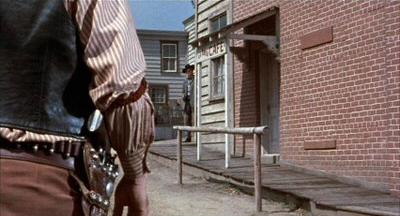
Everyone in Sundown loves Tate Kimbrough - until Randolph Scott rides in to show them what he's really like, inadvertently turning the dark
mirror on the townsfolk at the same time. Less exciting than the other three
"Ranown" westerns I've seen (Commanche Station, The Tall T,
Seven Men from Now) but with the best tagline: "His wife was a tramp... a
gun duel reveals the truth!" I think the movie's biggest problem is that, unlike
the other collaborations between Boetticher and Scott, this one isn't a journey:
it's staged entirely in a small town so that, unlike the others in the series,
you can really feel the small budget. I guess that's the thing with Westerns:
out in Monument Valley or Mesa Verde with a couple horses and some character
actors it still feels epic; add sets and they look like... cheap sets.
Interesting. Excellent performances by Noah Beery Jr. as Scott's partner who
refuses to die on an empty stomach, and by the great Larry Cohen regular Andrew
Duggan as the cowardly sheriff. It's a good thing I didn't read the back of the
ratty old vhs box I purchased at a flea market recently - it literally gives
away the entire movie. When are more titles from this brilliant Budd Boetticher
series going to be on dvd?
2.28. ROBOT REBELLION
NIGHT!
Westworld.
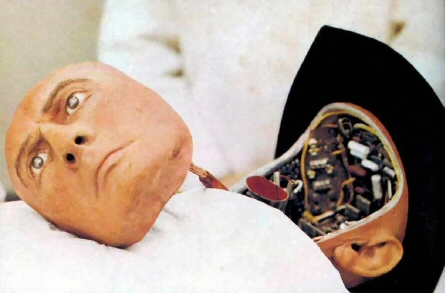 I know - I really should have seen Westworld 15 years ago, when I first heard about it. But it's one of
those flicks the plot to which you're so familiar, you sort of never bother
seeing it and just create the movie in your head over time. That said, the
actual version of Westworld didn't hold a candle to the one in my head,
although the scene of Brynner blowing James Brolin away was very satisfying
(that guy was enjoying his robot coitus too much...there was almost more android
sex than there was action, they should have called the movie
Breastworld.)
I know - I really should have seen Westworld 15 years ago, when I first heard about it. But it's one of
those flicks the plot to which you're so familiar, you sort of never bother
seeing it and just create the movie in your head over time. That said, the
actual version of Westworld didn't hold a candle to the one in my head,
although the scene of Brynner blowing James Brolin away was very satisfying
(that guy was enjoying his robot coitus too much...there was almost more android
sex than there was action, they should have called the movie
Breastworld.)
I'm surprised more lawsuits didn't happen since the release of this movie. Why didn't Brynner sue Schwarzenegger for stealing his stoic,
unstoppable killing machine character? Why didn't Richard Benjamin sue Jake
Gyllenhaal for stealing his Freddie Mercury-style cowboy stache? Why didn't
Michael Crichton sue himself after Jurassic Park was released? He
should have - that movie was a big hit, he'd have made a shitload of money.
Final word on this one: Yul Brynner's Gunfighter is to me more iconic than the
roles that inspired the character (Brynner in Magnificent Seven or
Invitation to a Gunfighter.)
Sins of the
Fleshapoids.
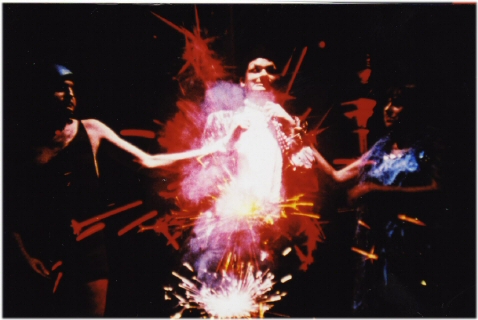 Mike Kuchar's Fleshapoids wait a little longer than Brynner to begin their revolt against the humans who've oppressed them: one million years in the
future, and they've been servants for 20,000. Bob Cowan plays the android slave
Xar, who looks like Conrad Veidt in wrestling tights wearing a conquistador's
helmet. He and his fellow androids turn on their masters and fall in love
between the silk curtains and plastic fruit in what may be the most extreme
meshing of Hollywood kitsch and decadent fantasy I've seen from the vast Kuchar
library. It's hilarious - the robot birth and death of George Kuchar's Prince
Gianbeno are scenes that need to be experienced. Watching this underground
classic, I felt sad thinking about how there'll be fewer beautiful 16mm films
made each year. Two other excellent Kuchar shorts are on this amazing dvd:
The Secret of Wendel Samson, starring outsider artist Red Grooms (check
out the amazing execution scene), and The Craven Sluck, featuring an
appearance by Mongreloid star Bocko the dog. Somebody start releasing
more Kuchar titles!
Mike Kuchar's Fleshapoids wait a little longer than Brynner to begin their revolt against the humans who've oppressed them: one million years in the
future, and they've been servants for 20,000. Bob Cowan plays the android slave
Xar, who looks like Conrad Veidt in wrestling tights wearing a conquistador's
helmet. He and his fellow androids turn on their masters and fall in love
between the silk curtains and plastic fruit in what may be the most extreme
meshing of Hollywood kitsch and decadent fantasy I've seen from the vast Kuchar
library. It's hilarious - the robot birth and death of George Kuchar's Prince
Gianbeno are scenes that need to be experienced. Watching this underground
classic, I felt sad thinking about how there'll be fewer beautiful 16mm films
made each year. Two other excellent Kuchar shorts are on this amazing dvd:
The Secret of Wendel Samson, starring outsider artist Red Grooms (check
out the amazing execution scene), and The Craven Sluck, featuring an
appearance by Mongreloid star Bocko the dog. Somebody start releasing
more Kuchar titles!
3.1. Altered
States.
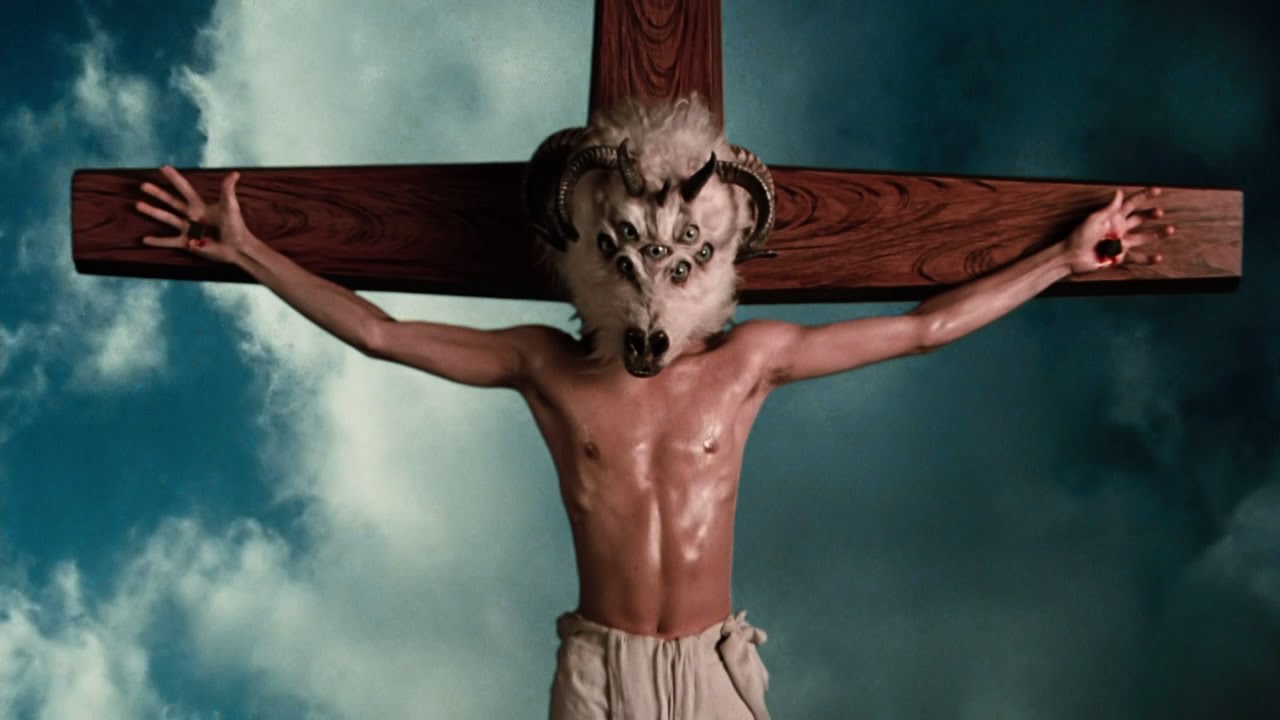
People have always asked me, "You've seen Altered
States, right?" and I pretend that they said, "You've played Altered
Beasts, right?" and nod. It was too embarrassing to admit that this was one
of those titles that fell through my movie-viewing cracks over the years... but
it was on t.v. so I decided to plant myself on the couch and strap myself in for
an enjoyable evening of Ken Russell insanity/inanity. 20 minutes in we've got a
seven-eyed goat head crucified on a floating cross and I know I won't be
disappointed. Amazing shot of Jessup in the door frame against white background.
William Hurt in this movie is the cleanest-looking person I think I've ever seen on film. His hallucinogenic visions are sort of anti-transcendent, going from
freak masturbatory religious images a'la The Devils to sensory
reflections as he makes his journey to godlessness. The image of he and Blair
Brown (she's one of those late 70s/early 80s lead actresses who I always think
they should have replaced with an attractive woman) turning into sand and
getting swept away is beautiful. Later on, when he transgresses into the primitive creature - that shit is scary. I'm actually glad I didn't see these scenes as a kid. I miss effects like these: everything in movies today looks too fucking perfect, or perfectly fake. I
'm surprised Brown got second billing: I feel like Drew Barrymore, John Laroquette, and the guy from the Police
Academy movies ("He's a fucking gorilla!" - great line) were in the movie
more than she is. Bob Balaban is even fuzzier than the ape-monster. In between
commercials I'm switching to Van Wilder on Comedy Central. Another great
silhouette of Jessup at the back of the house. The love-conquers-all ending is
exhausting (although the stuff in the hallway is guiltily mind-blowing), and
probably not what Russell wanted... he probably wanted Hurt to vomit frogs that
ate Barrymore and melded into the colorful cemetery statue of Jim
Morrison.
<<click here for 3/2/7 - 3/11/7>>
home about contact us featured writings years in review film productions
All rights reserved The Pink Smoke © 2010


 I have a weird relationship with the
Exorcist films. I like the idea of the first movie (and the original
novel) much better than the movie itself. The second is famously abysmal: it
upset me to learn that Martin Scorsese is a fan, as it cheapens his endorsement
of truly underrated movies like Cemetery Man and Shakes the
Clown.) The twin prequels are an evening's curiosity I've not yet indulged
in. And then there's Blatty's own film, an adaptation of his literary Exorcist
follow-up Legion, which is equally ridiculous and amazing. Taking place 15 years
later, this one sees minor characters from the first film being picked off by
possessed old ladies. I think the most interesting angle of the movie is that it
basically poses the question "What if the world were subtly coming to an end and you were the only one who noticed it happening?"
I have a weird relationship with the
Exorcist films. I like the idea of the first movie (and the original
novel) much better than the movie itself. The second is famously abysmal: it
upset me to learn that Martin Scorsese is a fan, as it cheapens his endorsement
of truly underrated movies like Cemetery Man and Shakes the
Clown.) The twin prequels are an evening's curiosity I've not yet indulged
in. And then there's Blatty's own film, an adaptation of his literary Exorcist
follow-up Legion, which is equally ridiculous and amazing. Taking place 15 years
later, this one sees minor characters from the first film being picked off by
possessed old ladies. I think the most interesting angle of the movie is that it
basically poses the question "What if the world were subtly coming to an end and you were the only one who noticed it happening?" 
 Much as I gushed about Vanishing
Point earlier in
Much as I gushed about Vanishing
Point earlier in 

 This is the first of several small movies Steven Soderbergh signed up to make, and the fact that none of the actors
being interviewed on the dvd extras are laughing about that time Catherine
Zeta-Jones snorted champagne off Brad Pitt's back on George Clooney's yacht off
the coast of Sicily is a good thing. I avoided this film because I wasn't sure
what to think of the politics behind releasing it in the theaters and on dvd
simultaneously (still don't know how I feel about that) but it was recommended so I went ahead and picked it up.
This is the first of several small movies Steven Soderbergh signed up to make, and the fact that none of the actors
being interviewed on the dvd extras are laughing about that time Catherine
Zeta-Jones snorted champagne off Brad Pitt's back on George Clooney's yacht off
the coast of Sicily is a good thing. I avoided this film because I wasn't sure
what to think of the politics behind releasing it in the theaters and on dvd
simultaneously (still don't know how I feel about that) but it was recommended so I went ahead and picked it up. 


